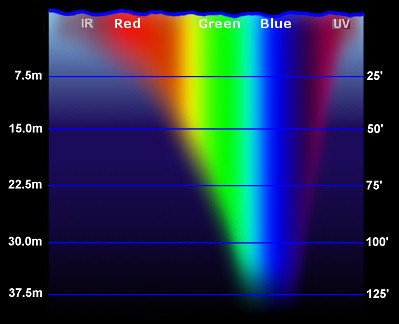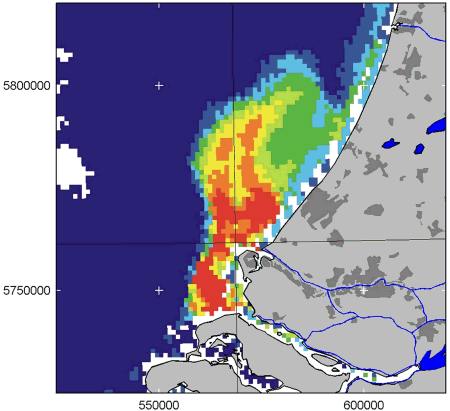1. Light and Life (7/8)
Sediment
In contrast to absorbing substances like chlorophyll in algae and CDOM, suspended particles (sediment) appear relatively bright in the remote sensing imagery because their main optical effect is that they scatter light.
Rivers
Notice the Rhine river plume at high discharge to deflect to the right as a result of Coriolis force. The Coriolis effect is an apparent deflection of moving objects from a straight path when they are viewed from a rotating frame of reference.
Now you have learned that with remote sensing there are four main componenents that can be detected in the coastal zone:
- Pure Water (H2O)
- Pigments in algae like Chlorophyll
- small particles, like Sediment (SPM)
- Coloured dissolved material, like CDOM
Note that example also contains a map for the light attenuation; the map with the heading Diffuse downward absorption coefficient. This is an important parameter for ecology, but also for divers and swimmers.
A fundamental principle
When light passes through water, it becomes attenuated by interaction with the water column. Different wavelengths of light (blue, green, red) will penetrate water to a varying degree:
- red light is attenuated rapidly and does not penetrate further than about 5 m in clear water.
- blue light penetrates much further and in clear water, the seabed can reflect enough light to be detected by a satellite sensor even when the depth of water approaches 30 m!

Source: Tom Morris, Fullerton College.
Attenuation as a danger
Attenuation means a decrease, in this case of the amount of light. Absorption and scattering attenuate the light into the water. Transparency or clarity is the antonym of attenuation. As a diver you will find out that below that water surface it rapidly gets darker in coastal waters with much sediment or algae.
Safety
The light field under water determines not only what you can see, but also whether others can see you. The light field in the water is influenced by the optically active substances in the water. Chlorophyll-a in phytoplankton absorbs in the blue and the red wavelengths. CDOM absorbs in the blue wavelengths, and sediment mainly scatters the light.
Did you know that... sight predators also need light in the water to hunt?
Question: Can you think of sea animals that need their eyes to hunt for prey?

